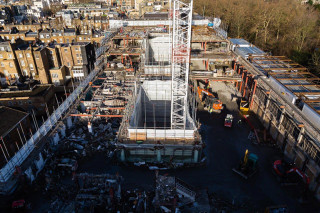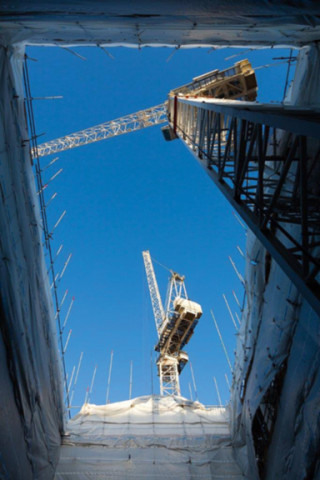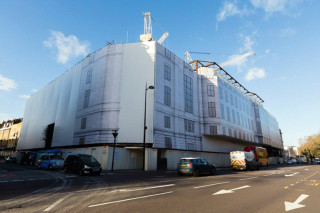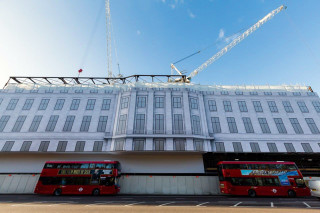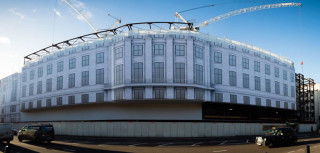Façade retention jobs are nothing new; in big cities like London, they’re almost commonplace. But each project has its own specific challenges, and 33 Grosvenor Place is certainly something of a one-off.
The project involves the complete demolition of a large six-storey office building in a prime location in London’s Belgravia, overlooking Buckingham Palace, to make way for a new ultra-modern private hospital.
The client is Cleveland Clinic, a leading US-based hospital group, which bought the building in 2015 for around £300m.
Erith Contractors has the main contract to carry out soft-strip, hard demolition and basement reconstruction within the shell of the existing structure, with façade retention to three elevations.
The contract requires Erith to lower the basement floor level by 1.5m, an extremely delicate task that entails transferring the load from the façade’s supporting columns onto temporary steelwork frames and then extending the columns down to rest on the newly-constructed basement slab.
Somewhat surprisingly, this isn’t the first time that 33 Grosvenor Place has been partially demolished and rebuilt. “The
internal guts were ripped out in the 1990s and new office accommodation was built behind the façade,” explains Erith’s operations director Grant Styles.
When the building was last remodelled, two enormous full-height glass atria were built through its middle to allow natural light into the offices. These will be filled in with new accommodation, but at the moment, they are occupied by two luffing tower cranes supplied by Select Plant.
Erith started work on site in February 2017 and is due to begin handing over to Sir Robert McAlpine (SRM), which has the main contract for the reconstruction phase, in August this year.
Due to the large size of the building, the demolition work is being phased so that work progresses from the southern end of the building northwards. SRM will commence construction of the new internal structure at the southern extremity before Erith has completed its demolition work at the northern end.
After scaffolding and decking out the two central atria, Erith started the soft strip by removing all the atrium glazing to facilitate early tower crane erection.
The demolition work is being carried out on a top-down basis, with demolition arisings conveyed down to a central material processing and loading area on the lower ground floor for sorting and removal from site. As demolition work progresses, material is fed into the loading and sorting area via “controlled vertical transfer”, says Styles, a euphemistic term for dropping material down the lift shafts.
This is not to say that there’s anything haphazard about the way the material is handled on site. Strict zoning ensures that nobody can stray into the vicinity of the loading area while material is being deposited, says Erith’s project manager Paul Millar: “There are constantly-moving exclusion zones to keep all work areas active. We require full segregation to protect the workforce at all times.”
While the soft-strip phase continued above, Erith concurrently carried out enabling works to allow the removal of arisings and the transit of materials and equipment around the site. This has included the removal of sections of the first, ground floor and lower ground floor slabs and steel frame to construct a ramp down into the loading and processing area.
Back-propping of the ground and lower ground floor slabs was also required to carry the load imposed by vehicles and plant entering the area.
After the soft-strip, Erith began the hard demolition work, using 13-tonne, eight-tonne and five-tonne excavators lifted into the upper storeys by crane. All the demolition plant used on the project is from Erith’s own fleet.
With the top-down demolition work underway, erection of the façade-retaining steel frame began. Supplied by Harrow-based fabricator ASME Engineering, this comprises 570 tonnes of steel and houses 40 site cabins, on hire from Select Plant. These cabins will provide office and welfare accommodation throughout the remainder of the construction project.
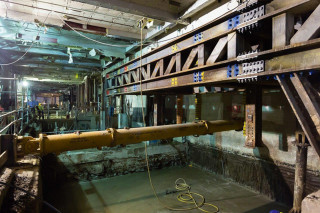
“All of the cabins were delivered and installed at night to minimise local disruption,” says Styles. “Special movement orders were also required because of the wide loads.”
The 40 cabins, now installed, are not visible from outside the site, however, as the entire building is now enveloped within a fabric wrap printed with a facsimile of the actual façade itself. The wrap is believed to be largest fabric building enclosure installed to date in the UK.
While the hard demolition work progresses above, work is also underway in the basement to transfer the loads imposed on the façade columns to temporary structural frames – each comprising around 65 tonnes of steel – to allow the existing basement slab to be broken ready for excavation to the new formation level.
“The new basement slab will be 1.5m below the original level to increase headroom in the basement,” explains Millar. “We have to excavate down 3.5m.”
Hydraulic jacks are used to transfer the load onto the temporary steel frames while ensuring there is no differential movement within the façade that could cause damage. The new basement slab is cast in sections and reinforced concrete extensions are installed beneath the existing steel façade columns to extend them to the reduced-level slab.

“The façade columns are steel, but we have used reinforced concrete to extend them rather than weld in steel extensions,” explains Styles. “The existing columns are complicated steel fabrications riveted together out of several pieces. It would be very difficult to splice new steel into them. Encasing them in reinforced concrete extensions is much simpler and it helped out programme,” he adds.
There are 51 of these façade columns to extend, divided among 21 bays. ASME Engineering fabricated four different types of temporary steel frame to suit the different bay layouts.
“The 21 bays mean we have to carry out the column lowering operation 21 times. It takes about eight weeks per bay, but we are working on five bays at any one time, completing them on a hit-and-miss basis.”
Performing this operation while at the same time carrying out hard demolition on the upper storeys makes for a complicated and potentially hazardous site, with so many operations taking place in close proximity.
But as Styles explains, any other method would have extended the build programme to an unacceptable degree.
“If the client had wanted a ‘blue-sky’ solution it would have added months and months,” says Styles. Millar agrees: “I think if we hadn’t done it this way, it would have taken an extra year.”
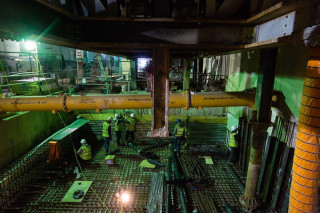
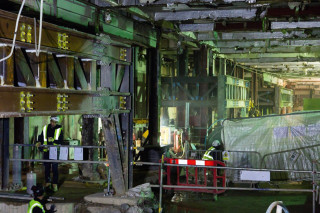
Foundation support for the façade retention frame was provided in the form of sixteen 20m-deep, 750mm-diameter concrete piles installed by restricted-access piling specialist Martello Piling, using a low-headroom rig.
Styles says that fundamental to the award of this contract was Erith’s BIM capability. Without it, co-ordinating the various concurrent demolition, temporary works and basement construction operations within the confines of the building would have been fraught with difficulty.
Swanton Consulting, Erith’s own in-house team of civil and structural engineers formulated the BIM execution plan (BEP) and provided all the information for the project’s common data environment (CDE) ensuring it was compliant to BIM Level 2. The CDE contains, among other things, 3D models, engineering calculations, CAD drawings and material schedules.
And despite the challenges thrown up by this project Erith is still on schedule to start handing over to SRM this summer. “We’re currently down to lower-ground floor level at the south end of the building and third floor level at the north,” says Millar. “We’re about 75% of the way through and on target to finish in August.”
Site team
- Client: Cleveland Clinic
- Architect: PLP
- Structural design: Waterman
- Building services: WSP
- Principal contractor (demolition): Erith
- Tower cranes: Select Plant
- Piling: Martello Piling
- Building wrap: Embrace Building Wraps
- Temporary steelwork: ASME Engineering
It’s a wrap!
The demolition and reconstruction of 33 Grosvenor Place could hardly be in a more sensitive location, surrounded as it is by prestige offices, foreign embassies – and not forgetting Buckingham Palace just across the road.
So to soften the visual impact, Erith commissioned a full-building fabric enclosure from Embrace Building Wraps, a specialist supplier based in Stow-on-the-Wold, Gloucestershire.
Embrace uses specialist equipment to produce wraps and sheeting bearing bespoke printed designs, photographs or tromp-l’oeil images of the structure behind it, as here in Grosvenor Place.
The wrap measures 3,572m2 and is believed to be the largest building wrap ever erected in the UK.
Besides vastly improving the site’s appearance, the wrap has the additional practical benefits of minimising dust and noise emissions while providing shelter from the wind and rain for those working on the building.
The wrap incorporates eight separate extended banner frames fixed to the retention system with 2,000 couplings and fittings. Over 800m of elasticated bungees are used to attach and tension the wrap.
This article was first published in the April 2018 issue of The Construction Index magazine, which you can read for free at http://epublishing.theconstructionindex.co.uk/magazine/april2018/
UK readers can have their own copy of the magazine, in real paper, posted through their letterbox each month by taking out an annual subscription for just £50 a year. See www.theconstructionindex.co.uk/magazine for details.
Got a story? Email news@theconstructionindex.co.uk

